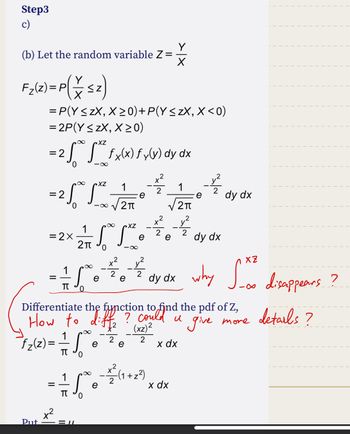Q 8.1. Suppose that X and Y are two random variables whose joint distribution is the standard Gaussian distribution in the plane. Let random variables R≥ 0 and = [0, 2π) satisfy X = R cos and Y = Rsin 0. (a) State the density of the joint distribution of R and O. (You do not need to derive this) (b) Express Z = in terms of and hence, making reference to part (a), calculate the density of the distribution of Z. It will help to try to picture this one.
Q 8.1. Suppose that X and Y are two random variables whose joint distribution is the standard Gaussian distribution in the plane. Let random variables R≥ 0 and = [0, 2π) satisfy X = R cos and Y = Rsin 0. (a) State the density of the joint distribution of R and O. (You do not need to derive this) (b) Express Z = in terms of and hence, making reference to part (a), calculate the density of the distribution of Z. It will help to try to picture this one.
Linear Algebra: A Modern Introduction
4th Edition
ISBN:9781285463247
Author:David Poole
Publisher:David Poole
Chapter7: Distance And Approximation
Section7.3: Least Squares Approximation
Problem 32EQ
Related questions
Question
100%
8.1

Transcribed Image Text:Q 8.1. Suppose that X and Y are two random variables whose joint distribution is the standard
Gaussian distribution in the plane. Let random variables R≥ 0 and = = [0, 2π) satisfy
X = R cos and Y Rsin 0.
(a) State the density of the joint distribution of R and O. (You do not need to derive this)
(b) Express Z = in terms of and hence, making reference to part (a), calculate the density
of the distribution of Z.
It will help to try to picture this one.
Expert Solution
This question has been solved!
Explore an expertly crafted, step-by-step solution for a thorough understanding of key concepts.
Step by step
Solved in 4 steps with 36 images

Follow-up Questions
Read through expert solutions to related follow-up questions below.
Follow-up Question
for part b, could u please provide more details of the calculations I circled? thanks

Transcribed Image Text:Step3
c)
(b) Let the random variable Z =
F₂(2)=P(X ≤2)
Put
= P(Y ≤ ZX, X ≥0) + P(Y ≤ ZX, X <0)
= 2P(Y ≤ ZX, X>0)
XZ
= 25° 5x² fx(x) fy(v) dy dx
0
-∞
V
2
2
= ²5² ²2/12 - 0 + 1 = 0 ²+² oy ox
2√² √x²
e
e
dy dx
0
√√2π
√2π
∞ XZ
= 2 × ²2²1 ²²² ²²0 +² oy dx
2
2
e
e dy
2₁
0 -∞
XZ
-15 oyce why 1.00 disappears?
-22
=
e
dy dx
π
-∞
details?
= 1/1 1 0 0
e
0
2
Differentiate the function to
x²
2
(xz)²
How to diffe
√₂ (2) = = √²0 = = = (42²³²
1
2
e
e
π
0
Ell
> ×
e
Y
X
?Cound the pdf of Z,
give
и
more
- 1/²/(1+2²)
x dx
x dx
Solution
Recommended textbooks for you

Linear Algebra: A Modern Introduction
Algebra
ISBN:
9781285463247
Author:
David Poole
Publisher:
Cengage Learning

Linear Algebra: A Modern Introduction
Algebra
ISBN:
9781285463247
Author:
David Poole
Publisher:
Cengage Learning